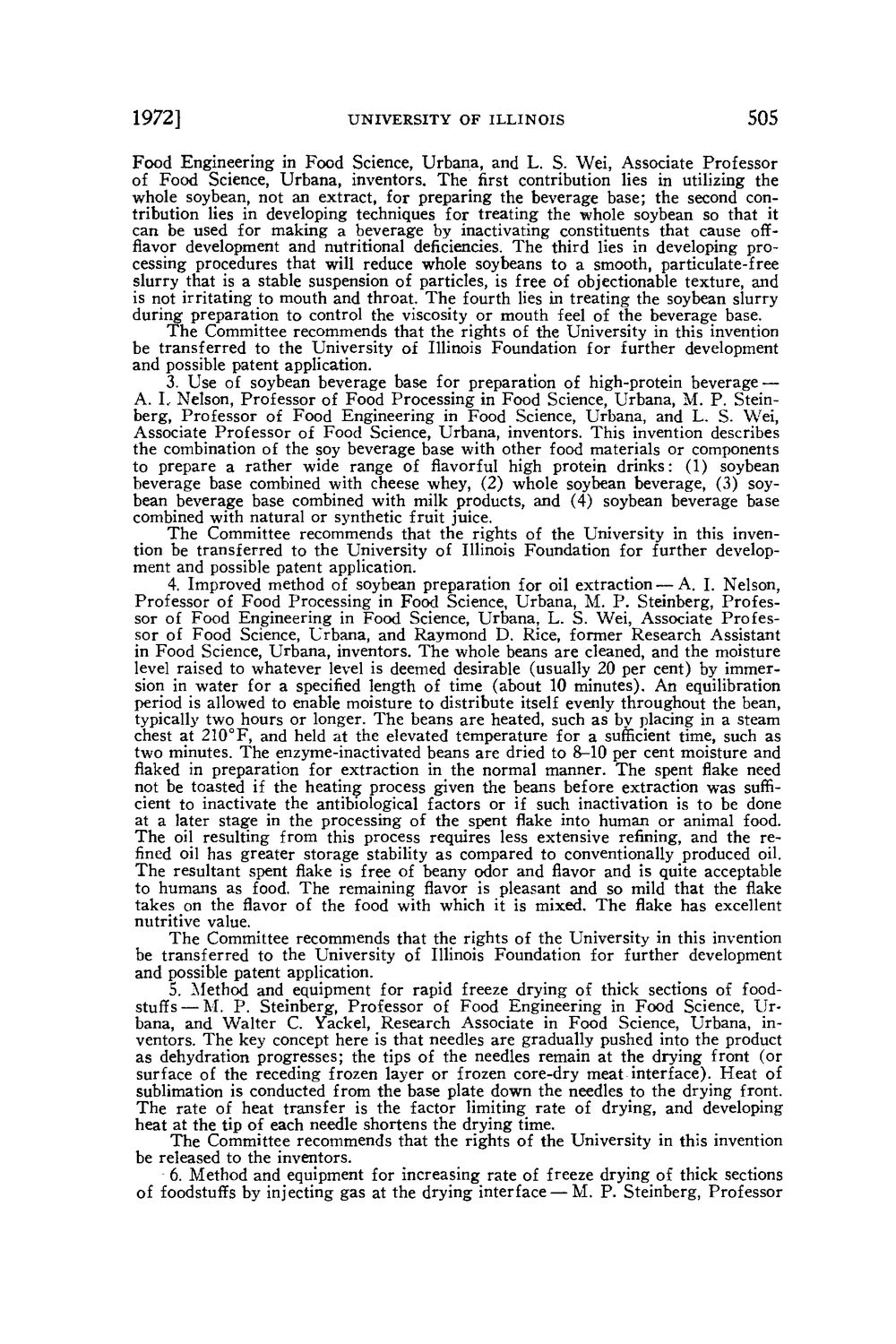| |
| |
Caption: Board of Trustees Minutes - 1972
This is a reduced-resolution page image for fast online browsing.

EXTRACTED TEXT FROM PAGE:
1972] UNIVERSITY OF ILLINOIS SOS Food Engineering in Food Science, Urbana, and L. S. Wei, Associate Professor of Food Science, Urbana, inventors. The first contribution lies in utilizing the whole soybean, not an extract, for preparing the beverage base; the second contribution lies in developing techniques for treating the whole soybean so that it can be used for making a beverage by inactivating constituents that cause offflavor development and nutritional deficiencies. The third lies in developing processing procedures that will reduce whole soybeans to a smooth, particulate-free slurry that is a stable suspension of particles, is free of objectionable texture, and is not irritating to mouth and throat. The fourth lies in treating the soybean slurry during preparation to control the viscosity or mouth feel of the beverage base. T h e Committee recommends that the rights of the University in this invention be transferred to the University of Illinois Foundation for further development and possible patent application. 3. Use of soybean beverage base for preparation of high-protein beverage — A. I, Nelson, Professor of Food Processing in Food Science, Urbana, M. P. Steinberg, Professor of Food Engineering in Food Science, Urbana, and L. S. Wei, Associate Professor of Food Science, Urbana, inventors. This invention describes the combination of the soy beverage base with other food materials or components to prepare a rather wide range of flavorful high protein drinks: (1) soybean beverage base combined with cheese whey, (2) whole soybean beverage, (3) soybean beverage base combined with milk products, and (4) soybean beverage base combined with natural or synthetic fruit juice. The Committee recommends that the rights of the University in this invention be transferred to the University of Illinois Foundation for further development and possible patent application. 4. Improved method of soybean preparation for oil extraction — A. I. Nelson, Professor of Food Processing in Food Science, Urbana, M. P . Steinberg, Professor of Food Engineering in Food Science, Urbana, L. S. Wei, Associate Professor of Food Science, Urbana, and Raymond D. Rice, former Research Assistant in Food Science, Urbana, inventors. The whole beans are cleaned, and the moisture level raised to whatever level is deemed desirable (usually 20 per cent) by immersion in water for a specified length of time (about 10 minutes). An equilibration period is allowed to enable moisture to distribute itself evenly throughout the bean, typically two hours or longer. The beans are heated, such as by placing in a steam chest at 210°F, and held at the elevated temperature for a sufficient time, such as two minutes. The enzyme-inactivated beans are dried to 8-10 per cent moisture and flaked in preparation for extraction in the normal manner. The spent flake need not be toasted if the heating process given the beans before extraction was sufficient to inactivate the antibiological factors or if such inactivation is to be done at a later stage in the processing of the spent flake into human or animal food. The oil resulting from this process requires less extensive refining, and the refined oil has greater storage stability as compared to conventionally produced oil. The resultant spent flake is free of beany odor and flavor and is quite acceptable to humans as food. The remaining flavor is pleasant and so mild that the flake takes on the flavor of the food with which it is mixed. The flake has excellent nutritive value. The Committee recommends that the rights of the University in this invention be transferred to the University of Illinois Foundation for further development and possible patent application. 5. Method and equipment for rapid freeze drying of thick sections of foodstuffs— M. P. Steinberg, Professor of Food Engineering in Food Science, Urbana, and Walter C. Yackel, Research Associate in Food Science, Urbana, inventors. The key concept here is that needles are gradually pushed into the product as dehydration progresses; the tips of the needles remain at the drying front (or surface of the receding frozen layer or frozen core-dry meat interface). Heat of sublimation is conducted from the base plate down the needles to the drying front. The rate of heat transfer is the factor limiting rate of drying, and developing heat at the tip of each needle shortens the drying time. The Committee recommends that the rights of the University in this invention be released to the inventors. 6. Method and equipment for increasing rate of freeze drying of thick sections of foodstuffs by injecting gas at the drying interface — M. P. Steinberg, Professor
| |